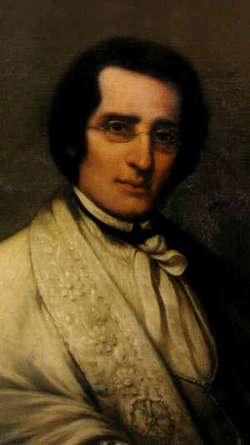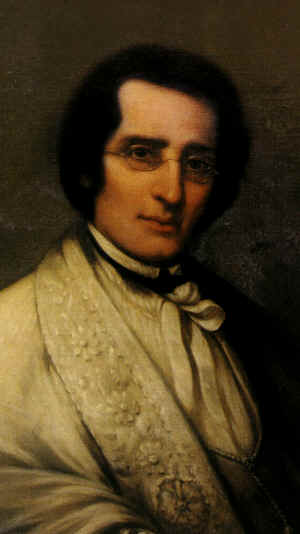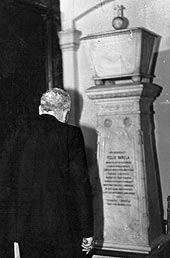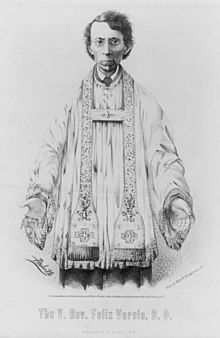Varela was born in Havana, Cuba, then part of New Spain, and grew up in St. Augustine, Florida, the grandson of Lieutenant Bartolomé Morales, the commander of military forces in Spanish Florida, who was stationed there and who helped to raise Felix after the death of his mother in childbirth.
As a teenager, he refused his grandfather's offer to send him to a military academy in Spain, returning to Cuba where he studied to become a priest at San Carlos and San Ambrosio Seminary in Havana, the only seminary in Cuba. He also studied at the University of Havana.
At the age of 23, he was ordained in the Cathedral of Havana for the Diocese of San Cristóbal de la Habana. Joining the seminary faculty within a year of his ordination, he taught philosophy, physics, and chemistry. During this period, he established a literary society and published Miscelánea filosófica, a popular book on philosophy, before he was 30 years old.
In 1821, he was chosen to represent Cuba in the Cortes Generales of Spain in Madrid, where he joined in a petition to the Crown for the independence of Latin America. He also published an essay which argued for the abolition of slavery in Cuba. For such ideas, after the French invasion of Spain in 1823 overthrew the government of Spain and restored King Ferdinand VII, who brutally suppressed all opposition, he was sentenced to death by the government.
Before he could be arrested, he fled, first to Gibraltar, then to the United States, where he spent the rest of his life in New York City. In New York, he founded El Habanero, the first Spanish-language newspaper in the United States, and other newspapers in Spanish. He published many articles about human rights, as well as essays on religious tolerance, cooperation between the English and Spanish-speaking communities, and the importance of education.
After studying English, he served as an assistant at St. Peter's Catholic Church on Barclay Street from 1825 to 1827. In 1827, he purchased a former Episcopalian church building, "Christ Church," on Ann Street and founded a new Catholic parish bearing the same name. By 1833, the building was beginning to become unsafe to use, and he then purchased land on James Street for the construction of a new church dedicated to St. James. In 1836, he also purchased a former Presbyterian church on Chambers Street, which he renamed Church of the Transfiguration. He served as the pastor there for his remaining time in New York.
In 1837, Varela was named Vicar General of the Diocese of New York, which then covered all of New York State and the northern half of New Jersey. In this post, he played a significant role in how the American Church dealt with the influx of Irish refugees. His gift for languages allowed him to master the Irish language to communicate more efficiently with the many recent Irish arrivals.
Varela served as a theological consultant to the committee of American bishops which drew up the famous Baltimore Catechism. He was later awarded a Doctorate of Theology by St. Mary's Seminary in Baltimore, Maryland.
In 1848, worn out by his labors, he developed severe asthma, which led him to retire to St. Augustine, dying there five years later. Nearly sixty years after his death, Varela's body was disinterred from Tolomato Cemetery and returned to Cuba to be laid to rest in the University of Havana's Aula Magna. The Cuban government created an award bearing his name, the Orden Félix Varela, given to those whom the government deems to have contributed to Cuban and worldwide culture. In 1997, the United States Postal Service honored Varela by issuing a 32-cent commemorative stamp.
Varela is being considered for canonization as a Catholic saint. On Easter Sunday, April 8, 2012, the Vatican's Congregation for the Causes of Saints declared him "Venerable," meaning that he lived a virtuous life to a heroic degree and is worthy of veneration.
Varela was born in Havana, Cuba, then part of New Spain, and grew up in St. Augustine, Florida, the grandson of Lieutenant Bartolomé Morales, the commander of military forces in Spanish Florida, who was stationed there and who helped to raise Felix after the death of his mother in childbirth.
As a teenager, he refused his grandfather's offer to send him to a military academy in Spain, returning to Cuba where he studied to become a priest at San Carlos and San Ambrosio Seminary in Havana, the only seminary in Cuba. He also studied at the University of Havana.
At the age of 23, he was ordained in the Cathedral of Havana for the Diocese of San Cristóbal de la Habana. Joining the seminary faculty within a year of his ordination, he taught philosophy, physics, and chemistry. During this period, he established a literary society and published Miscelánea filosófica, a popular book on philosophy, before he was 30 years old.
In 1821, he was chosen to represent Cuba in the Cortes Generales of Spain in Madrid, where he joined in a petition to the Crown for the independence of Latin America. He also published an essay which argued for the abolition of slavery in Cuba. For such ideas, after the French invasion of Spain in 1823 overthrew the government of Spain and restored King Ferdinand VII, who brutally suppressed all opposition, he was sentenced to death by the government.
Before he could be arrested, he fled, first to Gibraltar, then to the United States, where he spent the rest of his life in New York City. In New York, he founded El Habanero, the first Spanish-language newspaper in the United States, and other newspapers in Spanish. He published many articles about human rights, as well as essays on religious tolerance, cooperation between the English and Spanish-speaking communities, and the importance of education.
After studying English, he served as an assistant at St. Peter's Catholic Church on Barclay Street from 1825 to 1827. In 1827, he purchased a former Episcopalian church building, "Christ Church," on Ann Street and founded a new Catholic parish bearing the same name. By 1833, the building was beginning to become unsafe to use, and he then purchased land on James Street for the construction of a new church dedicated to St. James. In 1836, he also purchased a former Presbyterian church on Chambers Street, which he renamed Church of the Transfiguration. He served as the pastor there for his remaining time in New York.
In 1837, Varela was named Vicar General of the Diocese of New York, which then covered all of New York State and the northern half of New Jersey. In this post, he played a significant role in how the American Church dealt with the influx of Irish refugees. His gift for languages allowed him to master the Irish language to communicate more efficiently with the many recent Irish arrivals.
Varela served as a theological consultant to the committee of American bishops which drew up the famous Baltimore Catechism. He was later awarded a Doctorate of Theology by St. Mary's Seminary in Baltimore, Maryland.
In 1848, worn out by his labors, he developed severe asthma, which led him to retire to St. Augustine, dying there five years later. Nearly sixty years after his death, Varela's body was disinterred from Tolomato Cemetery and returned to Cuba to be laid to rest in the University of Havana's Aula Magna. The Cuban government created an award bearing his name, the Orden Félix Varela, given to those whom the government deems to have contributed to Cuban and worldwide culture. In 1997, the United States Postal Service honored Varela by issuing a 32-cent commemorative stamp.
Varela is being considered for canonization as a Catholic saint. On Easter Sunday, April 8, 2012, the Vatican's Congregation for the Causes of Saints declared him "Venerable," meaning that he lived a virtuous life to a heroic degree and is worthy of veneration.
Bio by: Angela
Advertisement
See more Varela y Morales memorials in:
Advertisement




